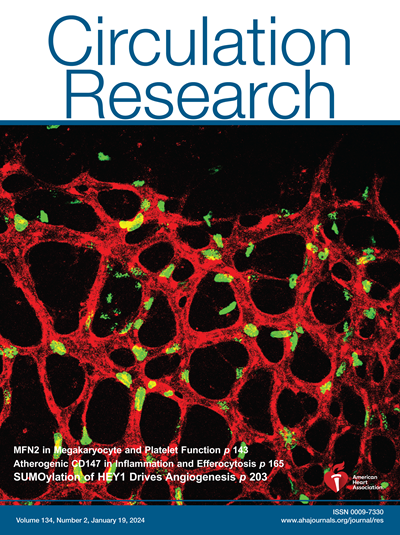Androgen Receptor Governs Tip Cell Formation in Cerebrovascular Malformations.
IF 16.2
1区 医学
Q1 CARDIAC & CARDIOVASCULAR SYSTEMS
引用次数: 0
Abstract
BACKGROUND Cerebrovascular malformations are a pivotal cause of hemorrhage and neurological disability, orchestrated largely by aberrant vascular homeostasis. However, a malformed angiogenic regulation pattern remains elusive. METHODS Single-cell transcriptome analysis uncovered the endothelial features of human cerebral cavernous malformations and brain arteriovenous malformations, 2 typical cerebrovascular malformation diseases. Endothelial AR (androgen receptor, a steroid receptor in the nuclear receptor superfamily) overexpression was conducted to investigate its involvement in tip cell formation. ARD-2585, an AR degradator, was applied to mouse models of cerebral cavernous malformations (endothelial-specific Pdcd10 knockout mice) and brain arteriovenous malformations (endothelial-specific KrasG12D mutant [KrasG12D] mice) to evaluate its vascular rescue potential. RESULTS We profiled single-cell transcriptomes of 13 human cerebrovascular malformation samples (10 cerebral cavernous malformations and 3 brain arteriovenous malformations) and 13 control brain samples, identifying a crucial pathological tip cell population in lesions. Integrative bioinformatics revealed a systemic endothelial regulatory network, with AR as a key regulator of this aberrant state. AR expression was elevated in endothelial cells from both human cerebrovascular malformations and Pdcd10 knockout/KrasG12D mice, correlating with suppressed DLL4 (delta-like canonical Notch ligand 4)-Notch signaling. AR overexpression augmented endothelial tube formation, filopodia extension, and polarization in vitro and fostered sex-independent vascular sprouting in vivo. High levels of AR facilitated proangiogenic gene transcription by recruiting coactivators EP300 (EP300 lysine acetyltransferase)/CBP (CREB binding lysine acetyltransferase), augmenting histone H3 lysine 18/histone H3 lysine 27 acetylation, and boosting chromatin accessibility, potentially independent of androgen. Notably, ARD-2585 treatment effectively normalized vascular anomalies and alleviated cerebral hemorrhage in Pdcd10 knockout and KrasG12D mice. CONCLUSIONS We delineated a novel androgen-independent AR-mediated endothelial sprouting pattern in malformed cerebrovasculature, highlighting a promising foundation for developing interventions targeting tip cells in angiogenic diseases.雄激素受体控制脑血管畸形尖端细胞的形成。
背景:脑血管畸形是出血和神经功能障碍的主要原因,主要是由异常的血管稳态引起的。然而,畸形的血管生成调节模式仍然难以捉摸。方法单细胞转录组分析揭示人脑海绵体畸形和脑动静脉畸形两种典型脑血管畸形疾病的内皮细胞特征。内皮AR(雄激素受体,核受体超家族中的类固醇受体)过表达研究其在尖端细胞形成中的作用。将AR降解剂ARD-2585应用于脑海穴畸形(内皮特异性Pdcd10敲除小鼠)和脑动静脉畸形(内皮特异性KrasG12D突变[KrasG12D]小鼠)小鼠模型,评估其血管拯救潜力。结果我们分析了13例人类脑血管畸形样本(10例脑海绵状畸形和3例脑动静脉畸形)和13例对照脑样本的单细胞转录组,确定了病变中关键的病理尖端细胞群。综合生物信息学揭示了一个系统性的内皮调节网络,其中AR是这种异常状态的关键调节因子。AR在人脑血管畸形和Pdcd10敲除/KrasG12D小鼠内皮细胞中的表达均升高,这与抑制DLL4 (δ -like canonical Notch配体4)-Notch信号传导有关。AR过表达增强了体外内皮管的形成、丝状足的延伸和极化,并在体内培养了性别无关的血管发芽。高水平的AR通过募集共激活因子EP300 (EP300赖氨酸乙酰转移酶)/CBP (CREB结合赖氨酸乙酰转移酶)、增加组蛋白H3赖氨酸18/组蛋白H3赖氨酸27乙酰化和提高染色质可及性促进促血管生成基因转录,可能不依赖于雄激素。值得注意的是,ARD-2585治疗有效地正常化了Pdcd10基因敲除小鼠和KrasG12D小鼠的血管异常并减轻了脑出血。结论:我们描述了一种新的雄激素不依赖型ar介导的畸形脑血管内皮发芽模式,为开发针对血管生成疾病尖端细胞的干预措施奠定了良好的基础。
本文章由计算机程序翻译,如有差异,请以英文原文为准。
求助全文
约1分钟内获得全文
求助全文
来源期刊

Circulation research
医学-外周血管病
CiteScore
29.60
自引率
2.00%
发文量
535
审稿时长
3-6 weeks
期刊介绍:
Circulation Research is a peer-reviewed journal that serves as a forum for the highest quality research in basic cardiovascular biology. The journal publishes studies that utilize state-of-the-art approaches to investigate mechanisms of human disease, as well as translational and clinical research that provide fundamental insights into the basis of disease and the mechanism of therapies.
Circulation Research has a broad audience that includes clinical and academic cardiologists, basic cardiovascular scientists, physiologists, cellular and molecular biologists, and cardiovascular pharmacologists. The journal aims to advance the understanding of cardiovascular biology and disease by disseminating cutting-edge research to these diverse communities.
In terms of indexing, Circulation Research is included in several prominent scientific databases, including BIOSIS, CAB Abstracts, Chemical Abstracts, Current Contents, EMBASE, and MEDLINE. This ensures that the journal's articles are easily discoverable and accessible to researchers in the field.
Overall, Circulation Research is a reputable publication that attracts high-quality research and provides a platform for the dissemination of important findings in basic cardiovascular biology and its translational and clinical applications.
 求助内容:
求助内容: 应助结果提醒方式:
应助结果提醒方式:


